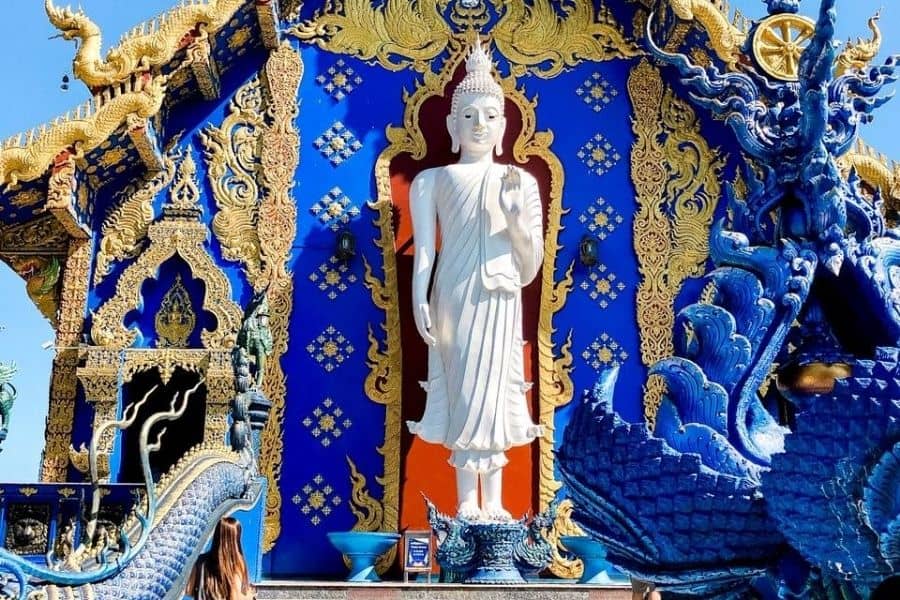20 Things to Know Before Traveling to Thailand
Planning to travel to Thailand? Get these 20 things to know before traveling to Thailand so you’ll have an amazing adventure!
If you’re looking for a magical place with soft white-sand beaches, turquoise waters, stunning gilded temples, and food to die for, look no further than Thailand. It’s a truly amazing place with a little something for everyone.
Just like any other place, Thailand has its unwritten rules and expectations, so it’s a good idea to be prepared before you go. Here are 20 helpful tips for Thailand that you should know before you go.

This post may contain affiliate links, which means I’ll receive a commission if you purchase through my links at no extra cost to you. Please read the full disclosure for more information.
1. Be Prepared for a Thai Massage
You can’t possibly consider going to Thailand without trying a Thai massage, and that’s why it’s on my list of tips for Thailand. However, I’ll give you a warning: Thai massage is deep. Very, very deep.
It includes a lot of stretching and manual manipulation so your body gets into positions you may not have thought possible before. But go with it, as it will feel exquisite once it’s done.
It can sometimes be a bit painful as they do go deep, but it’s a good kind of pain. It is done fully clothed as well, different from many Western massages.
There is also a type of Thai massage that is quite interesting and different from anything I have ever had. It’s called Tok Sen, or Tok Sen Massage.
It originated in northern Thailand and uses a wooden mallet to stimulate the energy points in the body. It’s probably unlike anything you have ever had and something I’d highly recommend if you have the opportunity.
You can get Thai massages throughout Thailand. I got a Thai massage (or two) at the Ao Nang/Krabi Town Ban Sainai Resort. Bangkok, the capital, is, of course, known for massage as well. Chiang Mai is well-known for massage as well as Tok Sen massage.
You May Also Like Tok Sen Massage—a Northern Thailand Experience
Thai Foot Massage
In Western countries, the idea of getting a foot massage may sound a bit strange. At least, it did to me before I first went to Southeast Asia.
But get over your Western hangups and give this a try. Whether it be a massage or acupressure, it’s amazing. And it’s a great way to feel better after a long day of walking.
My feet are super ticklish, and I didn’t even get pedicures for many years because of it. Even still, I literally climb the chair laughing with pedicures as I’m so ticklish. I got an acupressure foot massage in Thailand and, surprisingly, wasn’t all that affected by it.
They use a lot of pressure, and though my foot was a bit sensitive to start, it wasn’t overly ticklish. And oh my goodness, did it feel good!
There’s no better way to see Bangkok and Chiang Mai than walking, and you’ll walk a lot. A foot massage is a great way to help your toots keep up!

2. Remove Your Shoes
Similar to many Asian cultures, it is expected that you will remove your shoes before entering a temple. It’s also expected that you will do so when you enter someone’s house, as I learned when I entered my room in my Krabi Town resort, and when you enter a hotel room as well.
If you’re unsure, check at the entrance to see if there is a pile of shoes or if the staff are wearing shoes.
When visiting Thailand and Southeast Asia, bringing simple and comfortable footwear is a good idea. One of the helpful tips for Thailand is that you’ll want something you can easily take on and off as you will do it a lot.
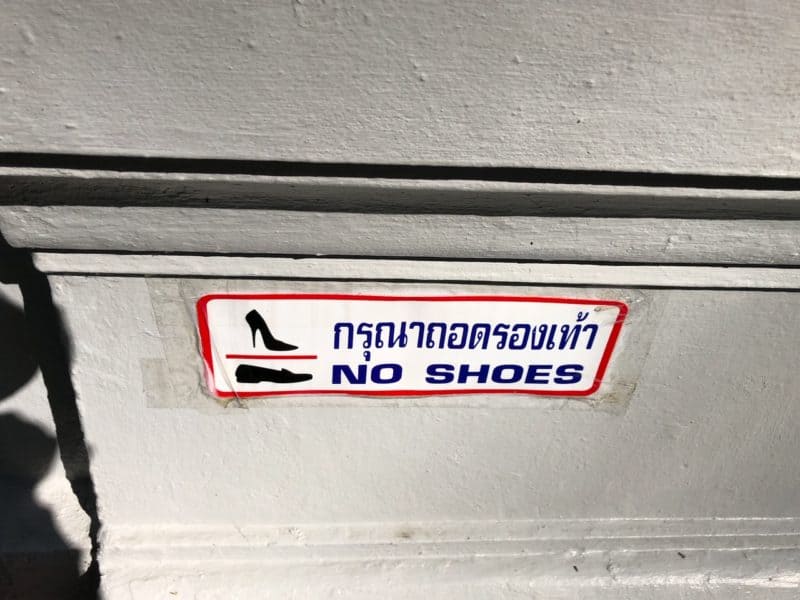
3. Leave Your Hands off Other’s Heads
While the feet are considered the dirtiest part of the body, the head is viewed as sacred. Never touch anyone’s head or hair, and this includes children.
You also don’t want to step over someone sitting or sleeping on the ground and don’t raise your feet above someone’s head.
4. Don’t Use Your Left Hand
The left hand is used for, ahem, “toilet functions,” so it shouldn’t be used for other things. Though this is how it used to be in many countries, I know my grandmother was trained to use her right hand as a child; it’s still one of the tips for Thailand.
If you are handing over money, do it with your right hand. Use your right hand if you are passing a bowl of food.
This one is especially hard for me as a leftie, and I’ll admit that I didn’t eat with my right hand. Imagine using chopsticks with your non-dominant hand, and what an unholy mess you’d make! Yep, I used my left; however, I noticed occasional looks.
5. Respect the Monks
It’s polite to see someone give you a wave to return it, just like if someone smiles at you. Monks are not required to, though providing them with one is still polite.
If you have something in your hand, a slight bow is appropriate. Never touch a monk, especially as a woman, nor should you touch their robes or even hand something to them.
During your first few days visiting Thailand, the monks will seem interesting and even a bit out of place. By your third day, they will seem so commonplace that you will hardly notice them.

6. Don’t Drink the Water
The water is quite clean in Thailand and is generally fairly safe to drink, depending on where you are.
However, it’s a good idea to avoid it if you are not from the area, and I have read that while the water is safe, the piles that carry the water aren’t always there. Not because the water is bad but because there are certain micro-organisms in different areas our body may not be used to.
They can have a similar effect, and having traveler’s diarrhea during a vacation is certainly something you want to avoid.
The same goes for eating fruit and vegetables. If it’s not cooked, it’s a good idea not to eat it as it has likely been rinsed in the water. (And if it hasn’t, you probably don’t want to eat it either!)
From what I read, ice is produced in several factories and usually uses filtered water, so it should be ok. The ice produced in these factories is tubular in shape, so it’s pretty easy to spot.
This is a good thing, as I did have iced drinks a few times in Thailand, which is so hot and humid, especially during certain times of the year. But thankfully, I was not “blessed” with any issues.
7. Be Careful with Taxis
Like any other country, you must always be careful with taxis and ensure they have an official medallion. You’ll want to determine the fare upfront or ensure the meter is on before leaving your destination. This is not only one of the tips for Thailand but for any country where you take a taxi.
Alternatively, you could take a tuk-tuk. I read about scams with tuk-tuks where drivers include stops that aren’t requested to try to push tourist items on the unsuspecting rider. I didn’t have that experience personally, and I think they are kind of fun to ride in.
You do have to negotiate the price upfront, and that often requires haggling. It’s not the most comfortable ride either, especially when the weather isn’t good or the pollution is high, as they are fully open. However, I think it’s a fun experience unique to this part of the world.
Another alternative is using a rideshare app, and Grab is the top app in this area. You don’t have to negotiate the price, and they are generally cheaper than tuk-tuks and taxis. There are safety measures with Grab, similar to Uber and Lyft, making this a good alternative.
8. Dress Modestly When Visiting Temples
It’s expected that visitors to temples will dress modestly, and that means covering your shoulders and knees. This applies to men and women, though there’s a tad more leniency regarding men and their knees.
If it’s hot and humid outside, which is a significant part of the time in much of Thailand, bring a scarf that you can wrap around your shoulders or your waist as needed. This is another of the tips for Thailand when visiting temples, and it’s important to keep in mind that you will be refused entry.
Many of the larger temple complexes, like the Grand Palace in Bangkok, have vendors and even shops nearby that will happily sell you a scarf for a higher price than you could get elsewhere.
Some industrious people will even rent a scarf. For women, having a scarf when you travel is just a good idea anyway, as you can use it in heavily air-conditioned restaurants for warmth as well.
You don’t want to miss seeing something amazing as you wear a sleeveless top, so do yourself a favor and cover up. It’s the respectful thing to do when you visit temples, and a good idea anyway in an area where the culture is a bit more modest than many of us are used to.

9. Learn to Barter
Similar to many other countries where markets are a primary way to make purchases, Thailand offers the opportunity to barter. It almost felt like I was back in the markets in Morocco, in places like Marrakech, Essaouira, and Casablanca.
It’s a bit quieter, as it’s culturally not appropriate to raise your voice in Thailand, and perhaps a bit less frenetic, but every bit as intense. This is one of the tips for Thailand and other countries with similar market cultures.
When you visit the markets and the night markets, try your hand at bartering. You’ll typically start at around 30% below the asking price and bargain from there. You may not feel comfortable, as I didn’t, as the prices are so low, to begin with. However, it’s expected and commonplace to do.
You can get even more than that if you purchase a few items, so consider the price and offer to get two for a little more than the asking price. In the worst case, you are rejected, and you walk away. Generally, they will try to stop you from leaving once you have expressed interest.
Don’t ask for the price if you’re not overly interested in an item. If you do and try to walk away, most vendors will believe you’re trying to barter and will approach you to try to negotiate.
10. Cash is King
Thailand is a country that relies heavily on cash. You may find some places, especially more Western-oriented hotels and restaurants, that accept credit cards, though many places take only cash. I found this several times with hotels that were not prepaid and scampered off to the ATM to pay up before I left.
Thankfully, hotels are reasonably cheap, so that I could withdraw enough money both times. But it’s one of the important tips for Thailand to keep this in mind to ensure you don’t end up in a tough situation!
The official Thailand currency is the Thai Baht (THB). You can get it at banks, ATMs, some hotels, and change kiosks (though the rate is never as good as at a bank).
It’s a good idea to load up on Baht as it’s the only legal currency in the country, and most places will not take U.S. dollars, Euros, or anything else.
Foreign Exchange
If you do decide to bring some of your local currency with you to exchange it, another tip for Thailand is to bring flawless bills. The exchange kiosks often won’t accept bills with marks or tears on them, and they will turn them down.
So, do yourself a favor and ensure when you pack that the bills you plan to take are flawless and can be accepted.
ATMs
ATMs are everywhere in the country, and you can find them in banks, convenience stores, and malls. However, Thailand seems to charge rather high fees to withdraw cash through ATMs, and some were as high as 200 Baht (over $6 USD).
While that may not seem like too high a charge, remember, you’re also going to likely pay a fee with your bank as well, so it could be doubled.
11. Learn a Few Key Phrases
Just like with any country you visit where you don’t speak the language, there are a number of great tips for handling a language barrier. One of the top tips for Thailand is that it’s a really good idea to learn a few key phrases. It’s polite and a good way to make a connection with someone and to show you are trying.
Thailand has some of the friendliest people, so they will generally try to help you. Even still, do your part and try to communicate when you can.
Helpful Thai Phrases
Here are some good phrases to know:
- Hello — sawatdii
- Goodbye — bai
- How are you — sabaaidii mai?
- I’m well — Sabaaidii
- I’m not well — mai sabaii
- Thank you — khop kum
- I come from (America) — pom/chan maa jaak (ameerigaa) [male/female]
- Sorry — khot hort
- Yes — chai
- No — mai
- How much — taorai
Don’t get too caught up on your pronunciation. Just making the effort to try to speak a little bit of Thai will go a long way.
12. Check if You Need a Visa
Several countries are not required to get a visa when visiting Thailand for a limited amount of time. The United States is one of the countries that allow a 30-day visit without a visa. There are options for more extended visits as well.
Sixty-four countries have a visa exemption to visit Thailand, including Canada, the United Kingdom, and Australia. It’s a good idea to check with your government to determine the need before you go.
If you’d like to stay for more than 30 days, people from many countries can get a tourist visa that allows for a 90-day visit and can be extended.
13. Don’t Expect Much Personal Space
In Thailand, as in many Asian cultures, the concept of personal space is pretty much non-existent. At least from a westerner’s perspective.
I think I like a bit more space than many people, at least with people I don’t know. Well, that’s not at all how it’s done here. You will be elbow-to-elbow with people in crowds, and even when you’re not in crowds, you’ll notice people drift toward you.
I laughed because I had people walking or standing within inches of me at several points in the trip when no other people were around!
Alarm bells started going off in my head, and my first thought was that they were trying to pickpocket. But I don’t think so. That’s just the culture and why this is one of my tips for Thailand.
I also found that people seemed to walk right at me. In Western cultures, people at a distance unconsciously move out of someone else’s path. Not here! It feels like they are aiming at you.
To be honest, I get a bit frustrated when it keeps happening. But, take a deep breath, and understand this is nothing personal but just the way it is here.

14. Slather Yourself in Bug Spray and Sunscreen
Thailand generally has a warm and humid climate, making it a wonderland for bugs, including mosquitos. There are lots of not-fun diseases that are mosquito-borne, like malaria, dengue, and Japanese encephalitis, to name a few.
Do yourself a favor and just avoid mosquitos as much as possible by always ensuring you have bug repellant on.
I use a few things on my trips: first, picaridin, and I love this stuff as it’s unscented. Deet may work well, but it’s unholy hell on my system, and I can’t tolerate it. I also spray my clothes with permethrin before I leave, lasting up to six washings.
And when I’m in particularly buggy areas and malaria zones, I also use a natural essential oil spray with lemon eucalyptus oils. I have known a couple of people who contracted dengue, and it’s something I highly recommend avoiding whenever possible.
Sunscreen is always a great thing to bring on any trip, and Thailand is no exception. It’s expensive in Thailand if you want to lighten your load and wait to buy it, and you may pay twice the cost you would at home or more.
So, do yourself a favor and bring some with you so you can spend your money on fun things.
15. Don’t Point
Pointing at a person is considered rude in Thailand, so it’s a good idea not to do it. Though it may feel a bit awkward, if you want to point to a person, simply lift your chin in their direction.
And if you want to motion for your waiter to come over on the rare times you’ll eat in a restaurant (Because of the street food… oh my!), make a patting motion with your hand facing down and your fingers pointing down as well.
Though you may point at things (not people), it’s considered more polite to use your entire hand instead of your finger.
It’s also considered rude to point your feet at someone. This mostly comes into play when you are in a temple looking at an image of the Buddha. Feet are seen to be dirty, so you don’t want to show them to people or aim them at people or the Buddha, which is revered in Thailand.
So, don’t sit with your feet up on anything; try to point your feet downward when you sit. There are several tips for Thailand about behavior in temples, and this is the first of them.
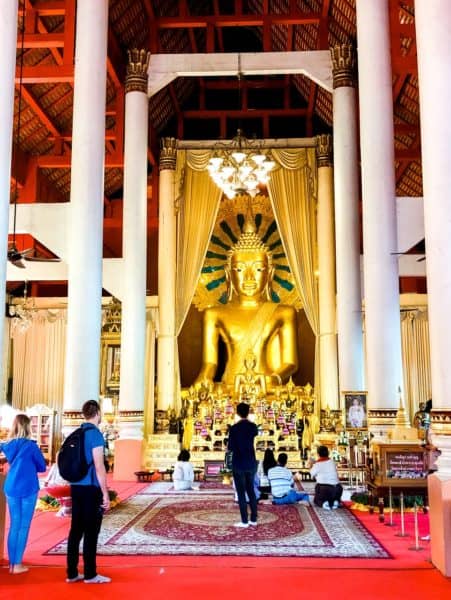
16.Get Your Vaccines
Several vaccines are recommended for visiting Thailand. This will depend on the country you live in currently, so it’s a good idea to check locally. For those in the United States, the Centers for Disease Control and Prevention (CDC) is the authority on this subject.
CDC recommended the following for travel to Thailand: hepatitis A and typhoid. A measles vaccine is also recommended in most Southeast Asian areas, even if you received the vaccine as a child.
Though it’s believed to offer lifetime protection, there have been cases of people who didn’t maintain immunity. Malaria and Japanese encephalitis are sometimes recommended, depending on where you go.
17. Avoid Thai Prison
Like anywhere you go, one of Thailand’s top tips is to ensure you know the law and what you can and cannot do in Thailand. Gambling is illegal except for betting on horse races and the government-run lottery.
All drugs are illegal in Thailand, including marijuana. Like any large city, you’ll find opportunities to buy anywhere. And especially in party towns like Patong in Phuket or in the red-light district in Bangkok.
Speaking of which, prostitution, though prevalent, is also technically illegal. You may find drug dealers and prostitutes working with police, trying to catch tourists. Do yourself a favor and avoid the situation. If you’re caught, you may have to pay a large fine or bribe or even face charges.
18. Respect the Buddha
When you visit Thailand, you’ll notice there are temples, Buddhist monuments, and images everywhere. Most of the country is Buddhist, so being respectful is a good idea. When you visit temples and religious places, one of Thailand’s top tips is to cover your shoulders and knees.
This also includes men, though they are often a bit more lenient. Don’t take any images of Buddha when leaving Thailand, including souvenirs and little statues. This isn’t the place to get a Buddha tattoo, either.

19. Eat Street Food
The best food in Thailand is served right out on the street. You’ll find food carts everywhere, and there are lots of markets and night markets as well. However, many countries, like Morocco, don’t have a large street food presence. Even when you see them in Morocco, they are generally not recommended.
Thankfully, Thailand is not one of those places. One of the top tips for Thailand is to take advantage of the affordable street food that you will find everywhere, including Bangkok, Chiang Mai, and other areas.
Enjoy the street food, though be smart about it. Sanitation standards are not what many Westerners are used to, so you will want to avoid raw meats. It’s a good idea only to eat food cooked in front of you to make reasonably sure it’s fresh.
And use your common sense—move on if it doesn’t smell fresh and appetizing. It’s also a good idea to be aware and to pick places with a crowd as you can better expect the food to be fresh.
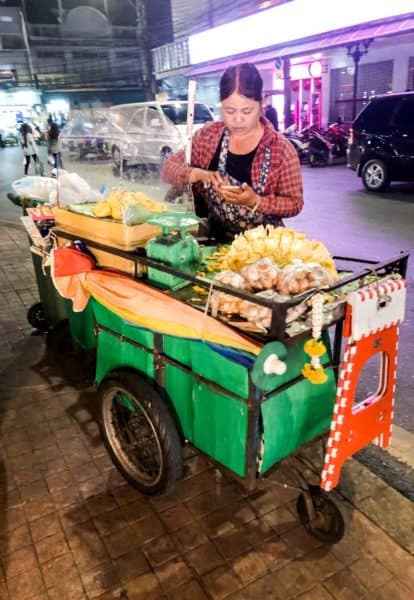
20. Beware Animal Tourism
Animal tourism is a huge tourist attraction in Asia and is prevalent in Thailand. Most people know not to ride elephants, and if you don’t, please be advised.
It’s a horrible and torturous process the elephants go through to be “broken” and tamed for riding. Sadly, many places promote themselves as “animal sanctuaries” only for profit and often don’t treat the animals any better.
You May Also Like Best Thailand Animal Sanctuary—Elephant Nature Park
This includes places that have tigers, elephants, and other animals. If you can go and safely snuggle a tiger, that tiger is likely heavily drugged, and it’s not a place you want to go to.
Many elephant places are the same way, and even if they don’t promote riding elephants, they may not have their best interests at heart. It’s crucial for you to do your research as you don’t want to support any of these organizations.
When I visited Chiang Mai, I did visit Elephant Nature Park. I did extensive research into this place and felt comfortable with my choice. Some may say this is still not a good thing to do, and I understand the concerns. They stem from the fact that to rescue these amazing animals, they have to pay for them.
Sadly, that supports the organizations that are torturing the animals to begin with. It’s a tough cycle, and you must do what feels right.
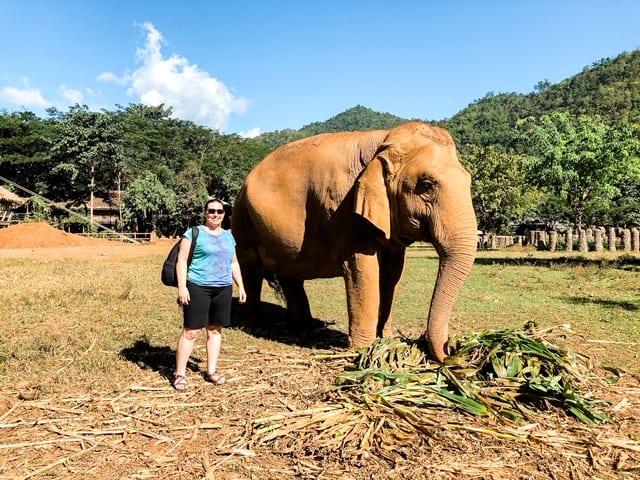
Thailand is a magical country with a lot of diversity, from beautiful beaches to thickly forested jungles, mountains, and large cities. Read through these tips for Thailand to have a great time while you’re there.
You Might Also Like
- The Best Places to Visit in Thailand
- Top Things to Do on a Chiang Mai Itinerary
- Tok Sen Massage—a Northern Thailand Experience
- Top Temples to Visit in Chiang Rai
- Best Thailand Animal Sanctuary—Elephant Nature Park
- The Best 2-Day Itinerary in Bangkok
- Why You Should Visit Lumphini Park in Bangkok
- Krabi Sunset Cruises—Best Thailand Cruise
- My Thai Paradise—Ban Sainai Resort in Krabi
Like it? Pin it!




